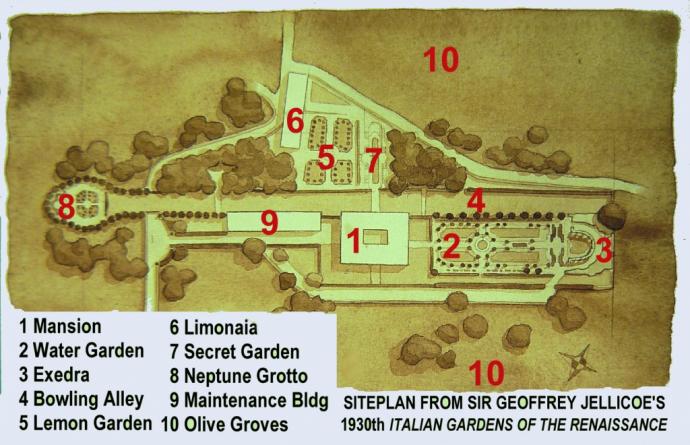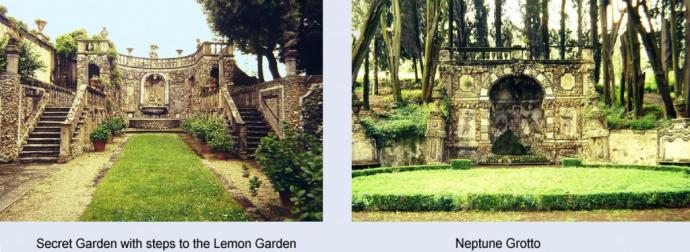Villa Gamberaia
VILLA GAMBERAIA is located on the sloping Settignano hills, beyond Fiesole and it is widely believed to be the most perfect example of a Renaissance garden in Tuscany. Visitors come from all over the world to see its famous Water Garden. Other attractions are an avenue of cypresses, the nymphaeum, a secret garden, a grotto, a limonaia with rows of lemon trees in large terracotta pots and a great exedra, which is a space surrounded by high hedges in which arches have been cut to create a superb view over the surrounding olive groves. Low hedges divide the garden into different areas or ‘rooms’ to break up the spaces.
HISTORY. Originally, a small dwelling stood on the site, housing Benedictine nuns. Gamberaia derived its name as ‘place of the crayfish (gamberi)’ which lived in a fish pond in the grounds.
In 1610 the villa was extended by the wealthy Florentine aristocrat Zanobi di Andrea Capi Lapi. Due to the presence of nearby springs, the property had an excellent supply of water in an area where water is often scarce. Due to legal proceedings against him, Zanobi eventually went bankrupt.
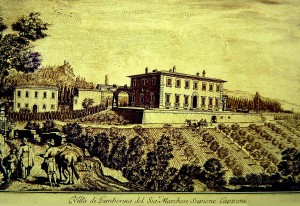 In 1717, the villa and grounds of the Villa Gamberaia were acquired by the Marchese Capponi. He commissioned a series of copper engravings to be made from drawings of the villa and its grounds.
In 1717, the villa and grounds of the Villa Gamberaia were acquired by the Marchese Capponi. He commissioned a series of copper engravings to be made from drawings of the villa and its grounds.
Towards the 1800s the villa and the much smaller Villa di Doccia formed part of an estate inherited by Lord Westbury, a compulsive gambler. Gambling losses meant that the noble lord had to rent out both villas. The American novelist and travel writer Edith Wharton visited Gamberaia after it had been purchased in 1898 by Princess Giovanna Ghyka, widow of a Romanian nobleman and sister of Queen Natalie of Serbia.
Princess Gyka paid for renovations to the villa and moved in there two years later with her English ‘lady’ companion named Miss Blood. The reclusive princess grew to love this beautiful villa and its garden to the point of passion. Obsessed by ageing, she insisted on wearing a heavy veil on her face as she walked in the gardens in the late afternoon and allowed very few visitors. Miss Blood was an occasional dinner guest of the Berensons at Villa I Tatti and she is mentioned by name in the edited letters of Mary Berenson, long suffering wife of Bernard Berenson, the philandering American art historian.
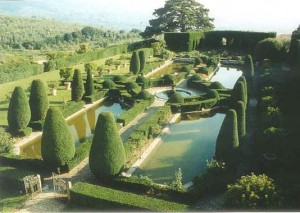 Rightly or wrongly, Mary Berenson was led to believe it had been Miss Blood who conceived the idea of turning the original crayfish pond into a Water Garden, while Princess Giovanna Gyka concentrated on developing the exedra beyond the Water Garden and the avenue of cypresses where she used to walk at dusk.
Rightly or wrongly, Mary Berenson was led to believe it had been Miss Blood who conceived the idea of turning the original crayfish pond into a Water Garden, while Princess Giovanna Gyka concentrated on developing the exedra beyond the Water Garden and the avenue of cypresses where she used to walk at dusk.
Martino Porcinai and Luigi Messeri were retained by Princess Ghyka to design the Water Garden consisting of four rectangular pools bordered by box hedges and beds of irises, lilies, roses and oleanders.
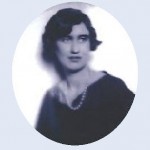
Iris Cutting, daughter of Lady Sybil, later to become Marchese Iris Origo, was allowed to visit the princess. Iris described Gamberaia as ‘the most romantic of all Tuscan gardens’. Edith Wharton also visited the garden and featured it in her Whartons’ book on Italian villas and gardens. Janet Ross a neighbour also visited Gamberaia and praised it in her book on Tuscan gardens as ‘true to the spirit of 17th century gardens in the neighbourhood of Florence’. Ross admired the grottoes lined with shells and the various statues and the arched fountain of rustic stone work.
Harold Acton loved Gamberaia and mentioned the ‘ravishing secret garden’, the grotto and fountain, the rococo statues and balustraded steps which lead to a lemon garden.
Australian writer Louise Mack, residing at the adjacent but much smaller Villa de Doccia on the outskirts of Settignano which had once formed part of the estate of Gamberia, was one of very few people allowed to visit. This was due to the fact that Miss Blood had been led to believe that Louise Mack, as editor of Florence’s Italian Gazette, was English rather than Australian. (Louise unable to divorce an alcoholic husband claimed to be a widow and wrote novels under her married name of Louise Creed). Assuming Louise to be an authority on Dickens and Thackeray (whose novels Miss Blood read aloud to her employer), Miss Blood showed her round the gardens. She loved the shimmering light reflecting in the pools of the water garden and admired the beautiful view from the exedra over Florence.
On the death of Princess Ghyka, American born Baroness Mathilda von Ketteler lived in the villa. She continued to maintain this magnificent garden possibly aided by Cecil Pinsent, the famous designer of Tuscan Gardens.
During World War 2, retreating German soldiers destroyed the gardens and torched the villa to ensure that American officers could not use it as their headquarters.
We photographed the gardens in 1996. Our visit had been arranged by our guide, Rupert Hodson, and solicitors acting for the late Marcello Marchi, whose death meant the villa was empty. Marchi’s nephew, Luigi Zalum, inherited his uncle’s property and has planted borders of iris and lavender along the parterres and several varieties of roses.
The address of Villa Gamberaia is, Via del Rosselini 72, 50135, Firenze-Settignano. Telephone: 55 697205. The villa is located 2 km from Settignano which lies 8 km to the north-east of Florence. Gardens are open from 9.30 am – 6 pm in summer (5 pm in winter) The villa is occupied by the owner and not open to visitors. www.gamberiai.com has details.


